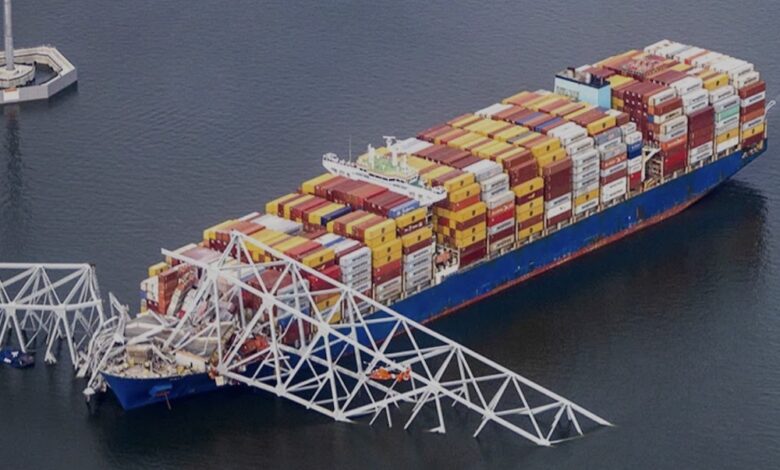Cranes move into place to remove Baltimore bridge debris

Cranes are being brought into place by barges as the authorities in Baltimore turn their attention to reopening the port, a tricky operation that will require the removal of thousands of tons of debris.
Tuesday’s allision between the 9,962 teu Dali boxship and the Francis Scott Key Bridge saw the city’s largest bridge collapse, killing six people, and making the majority of the port inaccessible.
The US Navy has deployed several floating cranes, including one that can lift up to 1,000 tons, while the US Army Corps of Engineers is sending more than 1,100 engineering specialists and other experts to begin removing the remains of the bridge, much of which is on the foredeck of the 300 m long Dali, pinning the giant ship to the riverbed below.
Federal officials yesterday announced the first relief funds. $60m is being sent for disaster recovery.
Maryland governor Wes Moore said at a Thursday news conference that getting the port back up and running normally would take a long time.
“This work will not take days. This work will not just take weeks. We have a very long road ahead of us,” Moore said.
Coast Guard Rear Admiral Shannon Gilreath outlined the intense work ahead: “Before we can actually engage in lifting, we’ve got to… figure out how to cut the bridge into the right size pieces so that we can actually lift them with the crane,” he said.
Mediterranean Shipping Company (MSC), the world’s largest containerline, warned customers earlier this week it will be “several months” before port operations return to normal and will omit Baltimore from its services “for the foreseeable future”.
Another issue making salvage tricky is the presence of a number of containers on the stricken ship containing hazardous cargoes. First responders observed a sheen around the vessel with booms quickly installed around the Dali. There are 56 total containers loaded on the vessel that contain hazardous materials. 14 were impacted in the accident. The 14 that were impacted were assessed by an industrial hygienist for potential hazards. The chemical components assessed were soap products, perfume products, or not otherwise specified resin.
The authorities have been conducting air monitoring on the vessel and around the vessel. No volatile organic compounds or flammable vapours have been observed.
The Dali’s voyager data recorder shows power failed for just one minute and three seconds as it approached the bridge, and that the lead pilot tried to swing the 2015-built vessel clear of a collision by dropping its port anchor to pivot it away.
The disabled ship, managed by Synergy Group and on charter to Maersk, ran into a support pillar and caused much of the bridge to tumble into the Patapsco River at roughly 1:30 am on Tuesday. Just moments before, at 1:26 am, the pilot of the ship called for tugboat assistance, according to the voyage data recorder. At 1:27 am, the pilot made an order to drop the ship anchor.
The disaster is likely to result in industry-wide multi-billion-dollar insurance claims, which could make it the largest single marine insurance loss, Lloyd’s of London chairman Bruce Carnegie-Brown told Reuters yesterday.
